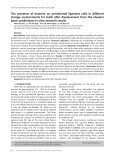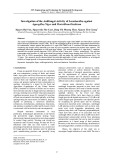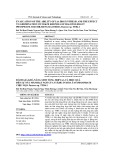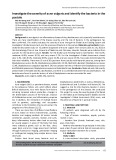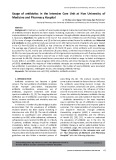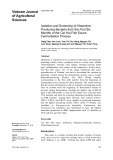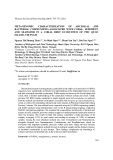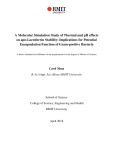Expression of Helicobacter pylori CagA domains by library-based construct screening Alessandro Angelini1,2,*, Tommaso Tosi1,*, Philippe Mas3, Samira Acajjaoui1, Giuseppe Zanotti2, Laurent Terradot1 and Darren J. Hart3
1 ESRF, Grenoble, France 2 Department of Chemistry, Institute of Biomolecular Chemistry, CNR, University of Padua, Italy 3 European Molecular Biology Laboratory, Grenoble Outstation, France
Keywords CagA; Helicobacter pylori; protein expression; type IV secretion system; virulence factor
Correspondence D. J. Hart, European Molecular Biology Laboratory, Grenoble Outstation, 6 rue Jules Horowitz, BP181, 38042 Grenoble Cedex 9, France Fax: +33 476 20 71 99 Tel: +33 476 20 77 68 E-mail: hart@embl.fr L. Terradot, ESRF, 6 Rue Jules Horowitz, BP220, 38043 Grenoble Cedex 9, France Fax: +33 476 20 94 00 Tel: +33 476 20 94 54 E-mail: terradot@esrf.fr
*These authors contributed equally to this work
(Received 22 October 2008, revised 1 December 2008, accepted 3 December 2008)
doi:10.1111/j.1742-4658.2008.06826.x
Highly pathogenic strains of Helicobacter pylori use a type IV secretion sys- tem to inject the CagA protein into human gastric cells. There, CagA asso- ciates with the inner side of the membrane and is tyrosine-phosphorylated at EPIYA motifs by host kinases. The phosphorylation triggers a series of interactions between CagA and human proteins that result in a dramatic change of cellular morphology. Structural and functional analyses of the protein have proved difficult, due to the proteolytically sensitive nature of the recombinant protein. To circumvent these difficulties, we applied ESPRIT, a library-based construct screening method, to generate a com- prehensive set of 5¢-randomly deleted gene fragments. Screening of 18 432 constructs for soluble expression resulted in a panel of 40 clones, which were further investigated by large-scale purification. Two constructs of approximately 25 and 33 kDa were particularly soluble and were purified to near homogeneity. CagA fragments larger than 40 kDa were prone to heavy proteolysis at the C-terminus, with a favoured cleavage site near the first EPIYA motif. Thus, these well-expressed recombinant constructs iso- lated are likely to be similar to those observed following natural proteolysis in human cells, and open the way for structural and functional studies requiring large amounts of purified material.
and lymphoma of adenocarcinoma,
codes for 29 proteins involved in the assembly of a type IV secretion system (T4SS) [6,7]. T4SSs are used by many bacteria for genetic conjugation, high- frequency recombination, and delivery of effector mac- romolecules [8]. The cag-encoded T4SS forms a long is necessary to deliver the effector appendage that protein, CagA, into gastric epithelial cells [9,10].
Abbreviations cag-PAI, cytotoxin-associated gene pathogenicity island; IPTG, isopropyl thio-b-D-galactoside; T4SS, type IV secretion system.
FEBS Journal 276 (2009) 816–824 ª 2009 The Authors Journal compilation ª 2009 FEBS
816
Helicobacter pylori is a human pathogen that infects more than half of the human population [1,2]. It is considered to be the main cause of most gastric including chronic gastritis, peptic ulcer, pathologies, gastric the mucosa-associated lymphoid tissue [3]. Infection with H. pylori strains carrying the cytotoxin-associated gene pathogenicity island (cag-PAI) leads to a higher risk of gastric cancer [4,5]. This gene cluster of around 40 kb Once injected inside target cells, CagA associates with the inner side of the cytoplasmic membrane and
A. Angelini et al.
Expression of Helicobacter pylori CagA domains
the phenotype hummingbird through
major, if not the only, phosphorylation sites in CagA [29], and sequences within the EPIYA motifs also mediate the attachment to the membrane [30]. In addi- tion, the multimerization of CagA mediated by EPIYA motifs seems to be a prerequisite for the interaction with the SHP-2 phosphatase. Finally, the CagA C-ter- minus mediates translocation inside human gastric cells. A lysine-rich motif located within the last 20 resi- dues is necessary, together with the CagA N-terminus, for the translocation of the protein [27]. Furthermore, CagF, another component of the cag-PAI, is known to interact with a stretch of 100 amino acids located at the CagA C-terminus, just upstream of the C-terminal motif necessary for translocation [24,31]. Finally, the pilus-associated protein CagL is required to facilitate the receptor interaction prior to injection of CagA [32].
including is tyrosine-phosphorylated by host kinases, c-Src, Lyn, Fyn, Yes and c-Abl [11]. Phosphorylated CagA then binds several SH2 domain-containing host proteins involved in signalling pathways, including the SHP-2 phosphatase, Csk tyrosine kinase, and the Crk adapter protein [12–14]. These events ultimately result in cellular morphological changes known as the ‘hum- mingbird phenotype’, and enhance cellular motility, resulting in cell scattering [11,15–17]. Phosphorylated CagA has also been found to interact with PAR1 ⁄ MARK kinase, promoting both cell polarity defects and the inhibition of PAR1 phosphorylation [18]. Several CagA-mediated effects are independent of its phos- phorylation status. CagA is known to interact with the scaffold protein ZO-1 and also the tight junctional adhesion protein JAM, leading to a redistribution of tight junction proteins and the alteration of apical– junctional complex function [19,20]. An increase in cell motility is furthermore induced by the intracellular interaction of CagA with the scatter factor receptor c-Met, which deregulates the c-Met receptor pathway and thereby induces cell invasion [21,22]. The C-termi- nal portion of CagA has also been found to interact with Grb2, triggering a Ras-dependent signalling path- way that results in increased cell scattering and pro- liferation [23].
Although these data clearly define the C-terminal region as being of great functional importance, infor- mation about the boundaries of domains involved in protein–protein interactions and their in vitro biochem- ical and structural characterization is limited. In order to investigate the biochemistry and structure of CagA, we sought to identify soluble fragments in the C-termi- nal region of CagA for use in subsequent studies. As CagA has no significant sequence homology with other proteins, it was impossible to identify putative domains through analysis of multiple sequence alignments. We therefore used a recently developed high-throughput screen for soluble constructs, ESPRIT (expression of soluble proteins by random incremental truncation) [33–35], in which a comprehensive 18 432 clone ran- dom library of 5¢-deletion constructs was synthesized and screened for soluble expression. A panel of C-ter- minal fragments was isolated that were well expressed in Escherichia coli and purifiable by affinity chroma- tography. Endogenous proteolysis of several of these fragments led to further refinement of domain bound- aries. The resulting constructs will be of significant use in biochemical and structural studies on the role of this important virulence factor.
Results
Library construction
FEBS Journal 276 (2009) 816–824 ª 2009 The Authors Journal compilation ª 2009 FEBS
817
An exonuclease III and mung bean nuclease truncation protocol was performed on a precloned cagA gene to generate a comprehensive random library of constructs in which most (if not all) possible fusion points of a cleavable N-terminal hexahistidine tag were present. One-third of the constructs were in-frame with this sequence, resulting in T7 promoter-driven expression CagA effects exerted in vivo are mediated by pro- tein–protein interactions with host cell components. However, the biochemistry of CagA and of its interac- tions remains largely elusive, because the full-length protein is unstable in recombinant expression systems and rapidly degraded [24]. The purification of a CagA fragment (from residues 392–733) has been previously reported, and this was shown to bind HpYbgC in vitro [25,26], but the biological relevance of this interaction has yet to be elucidated. The N-terminal 57 residues interact with ZO-1 and JAM [19] and contain a sequence important for translocation by the T4SS [27]. The C-terminus of CagA contains the tyrosine phos- phorylation sites, which are major determinants of its mode of action. One phosphorylation site comprises a stretch of 34 residues including the five amino acid EPIYA motif. EPIYA motifs can be found multiple times in the C-terminal region of the protein, depend- ing on the bacterial strain [11]. Whereas the first two motifs (EPIYA-A and EPIYA-B) are conserved among all strains, Western isotypes possess 0–4 copies of the EPIYA-C motif, thereby explaining the variation in molecular mass observed in different CagA proteins. Furthermore, the Eastern CagA isotypes do not carry an EPIYA-C motif, but a different sequence, EPIYA– D [28]. The EPIYA-C and EPIYA-D motifs are the
A. Angelini et al.
Expression of Helicobacter pylori CagA domains
site common to all fragments larger
than start 1500 bp; these constructs were eliminated, due to the absence of hexahistidine tag.
Ninety-six clones comprising the 32 highest express- ers from each sublibrary were assessed for insert size by PCR and simultaneously for expression of Ni2+- nitrilotriacetic acid purifiable protein from 4 mL cultures. Proteins eluted in the imidazole-containing buffer were visualized by SDS ⁄ PAGE and western blot performed with both fluorescent streptavidin and anti- body against hexahistidine tag (Fig. 1C).
Analysis of expression clones
constructs. All constructs were fused in-frame with a C-terminal biotin acceptor peptide used as a marker for protein solubility and stability during colony screening. The library was divided into three insert size ranges (500–1500, 1500–2500, and 2500–3500 bp) by size selection on agarose gel to reduce the dominance of small expression constructs. The resulting sub- libraries were handled separately thereafter. Colony PCR and DNA sequencing of unselected clones indi- cated an approximately even distribution of construct sizes, with no obvious bias. The frequencies of ampli- fied DNA inserts were 40% (13 ⁄ 32), 56% (18 ⁄ 32) and 47% (15 ⁄ 32), representing minimum insert efficiencies for the three sublibraries. The pooled sublibraries were used to transform BL21-CodonPlus(DE3)-RIL, and 18 432 colonies (6144 for each sublibrary) were picked into 384-well plates. The minimum insert efficiency combined with the length of the gene (3561 bp) predicts an approximately threefold oversampling of constructs.
Assessment of clones for soluble purifiable protein expression
containing
tags were
Of the 96 constructs tested, three short constructs [20.3 (not shown), 29.2 and 29.7 kDa) and six medium con- structs (36.4, 37.4, 41.6, 42.1, 42.2 and 44.5 kDa) were well expressed, and purified as a single band (Fig. 1C). Sizes of the proteins were predicted from DNA sequencing of inserts and confirmed by SDS ⁄ PAGE (including 5 kDa of tags). Nineteen other constructs were purified, but displayed weak bands by fluorescent western assay, suggesting that levels of soluble expres- sion were very low. Nineteen further constructs between 45 and 60 kDa exhibited significant degrada- tion. Owing to the weak nature of many of the bands, western blot analysis was also performed using strepta- vidin and antibody against hexahistidine to confirm the SDS ⁄ PAGE results. The remaining 49 constructs showed no significant protein expression in these small-scale experiments, and so they were not studied further, due to lack of expression (false positives) or because of the requirement for inconvenient scale-up. Further sequencing identified the expression-compati- ble N-termini and revealed a total of 40 unique sequences that were in-frame with the hexahistidine tag. Significant heterogeneity at the tag fusion position was observed (Fig. S1). A three-step solubility screening process was employed (Fig. 1A): (a) robotically arraying clones on nitrocellu- lose membranes; (b) growing colonies; and (c) inducing protein expression by shifting membranes to agar thio-b-d-galactoside plates isopropyl (IPTG). Putative soluble expression clones were iso- lated from each sublibrary by analysing membranes hybridized simultaneously with Alexa488 streptavidin and a monoclonal anti-hexahistidine tag with associ- ated Alexa532 mouse secondary antibody (Fig. 1B). intensities for both N-terminal and Values of signal C-terminal into extracted from arrays Microsoft Excel, and an initial filtering was applied to eliminate all clones with no detectable hexahistidine tag signals.
Scale-up expression and purification
FEBS Journal 276 (2009) 816–824 ª 2009 The Authors Journal compilation ª 2009 FEBS
818
lower molecular mass was detectable In total, 9635 colonies showed some signal for the N-terminal hexahistidine tag and were subsequently ranked for streptavidin fluorescence, resulting in 453 clones with significant signals for both tags. In this way, clones exhibiting only one terminus due to inter- nal translational initiation, premature translational ter- mination or proteolysis were removed, generating a higher-quality subset for subsequent liquid expression testing and purification trials. Indeed, we observed a high number of clones in medium and large insert sublibraries exhibiting strong C-terminal biotinylation signals, but a complete absence of detectable hexahisti- dine tag. This effect was not found in the small subli- brary, and is suggestive of an internal translational One litre scale protein expression trials were per- formed on all unique clones exhibiting detectable pro- tein expression in small-scale experiments, and Ni2+- nitrilotriacetic acid purification was performed using 1 mL His-trap columns. Two proteins of 25 and 33 kDa were purified as a single band in SDS ⁄ PAGE (Fig. 2A; clones 8 and 37) at high yield and quality. Five larger constructs (Fig. 2A; clones 94, 90, 70, 83 and 88) revealed proteins of 81, 87, 95, 106 and 107 kDa. They were also purified, but a second band of in the SDS ⁄ PAGE gel. Western blot analysis of these five
A. Angelini et al.
Expression of Helicobacter pylori CagA domains
B
A
Construction of the CagA fragment library
Membrane scanned at 532 nm
Robotic processing of library
N-term. hexahistidine tag detection
18432
Expression and solubility screening
Membrane scanned at 488 nm
i
λ = 532 nm
C-term. biotin acceptor peptide detection
9635
i
λ = 488 nm
453
Membrane scanned at 532 nm and 488 nm
Ranking
l
Dual detection
g n n e e r c s n o s s e r p x e y n o o C
96
C
Clone
3
61
37
56
45
60
6
8
M
i
E. coli protein expression
S W S W S W S W S W S W S W
S W
IMAC purification [TECAN robot]
170 130 100 70 55 40
SDS-PAGE + Western blot
i
35
i
25
Sequencing
g n n e e r c s e r u t l u c d u q L
40
15
Scale-up
M
29.2 kDa 29.7 kDa 36.4 kDa 37.4 kDa 41.6 kDa 42.1 kDa 42.2 kDa 44.5 kDa
Fig. 1. Screening for protein expression and solubility from a CagA random truncation library. (A) Flow chart for improving CagA protein expression and solubility. A library of 18 342 clones of 5¢-random cagA truncations was robotically picked and gridded onto nitrocellulose agar to grow colony arrays in which protein expression was induced and assessed by intensity of N-terminal hexahistidine tag and C-terminal biotin acceptor peptide signals. The 96 best ranked clones were purified from small-scale expression cultures by Ni2+-nitrilotriacetic acid puri- fication. From SDS ⁄ PAGE analysis, 40 constructs were selected for larger-scale purification. (B) Colony-based solubility screening of the con- struct library. Example of detection of N-terminal hexahistidine (red, top panel), C-terminal biotinylation (green, middle panel), and merged image (lower panel). (C) Testing of putative soluble CagA fragments by purification on Ni2+-nitrilotriacetic acid agarose from 4 mL expression cultures. Results are presented for eight of the 96 clones tested showing successful outcomes. For each clone, the Coomassie blue-stained SDS polyacrylamide gel (S) is displayed alongside fluorescent western blot analysis (W) of the same sample. An overlay of the hybridizations with antibody and streptavidin [as in (B)] is presented, showing the presence of both genetically encoded protein termini, indicating proteolyt- ically stable fragments. Protein molecular mass markers are indicated (M ).
with the same N-terminal residues as clones 90 and 94, these five asparagines respectively, but ending at (Fig. 2B). The expression and purification of these new constructs resulted in stable purifiable domains exhibit- ing little degradation and located internally within the CagA sequence (Fig. 2B).
Discussion
FEBS Journal 276 (2009) 816–824 ª 2009 The Authors Journal compilation ª 2009 FEBS
819
The pathogen H. pylori uses a T4SS to inject the CagA pathogenicity factor into human gastric cells, where it perturbs host signalling pathways to provide fragments with antibodies against hexahistidine tag indicated that the subfragments correspond to trun- cated proteins lacking a C-terminal portion of about 33 kDa (Fig. 2A). This repeated pattern suggested that these constructs were all expressed and soluble but contained a C-terminal domain that was particularly prone to proteolysis in E. coli cells. From the size of the fragments and the CagA sequence, we hypothe- sized that the C-terminal domain cleaved in these con- started at a stretch of five asparagines, structs corresponding to residues 885–889 (Fig. 2B,C). We thus designed two new constructs, 90DC and 94DC,
A. Angelini et al.
Expression of Helicobacter pylori CagA domains
B
A
C
Fig. 2. Expression of soluble C-terminal CagA fragments. (A) Seven CagA protein fragments (clones: 8, 37, 94, 90, 70, 88 and 83) of differ- ent sizes (25, 33, 87, 81, 95, 106 and 107 kDa, respectively) were expressed at 1 L scale with an N-terminal hexahistidine tag and purified by Ni2+-nitrilotriacetic acid affinity chromatography. All purified parental fragments are indicated with an arrow. From left: clones 8 and 37 (25 and 33 kDa, respectively) show relatively high proteolytic stability, whereas five other constructs (clones 94, 90, 70, 83 and 88) clearly show the presence of a cleaved ‘subfragment’ (indicated by an asterisk). (B) Clones 94DC and 90DC, subcloned from clones 94 and 90 with deletion of a C-terminal fragment (around 33 kDa), express proteolytically stable, purifiable protein fragments as assessed by SDS ⁄ PAGE. (C) Summary diagram of CagA constructs yielding purifiable fragments. Above: a schematic view of the CagA protein sequence. N-terminal and C-terminal translocation signals are orange, the stretch of five asparagines (885–889) is grey, EPIYA motifs are dark red, and multimer- ization motifs are dark green. Below: the positions of the purifiable fragments are indicated by solid bars. Yellow bars indicate C-terminal constructs exhibiting little proteolytic degradation. Blue bars are constructs yielding mixtures of both unproteolysed and proteolysed frag- ments, the latter corresponding to loss of the C-terminal region. Pink bars represent clones that were subsequently constructed by deleting the region corresponding to the longer stable C-terminal construct (clone 37) shown in yellow.
purified with a yield high enough for structural stud- ies and high protein consumption in vitro analytical methods. All possible 5¢-unidirectional truncations of the target gene were generated and tested for soluble expression using high-throughput screening robotics [33]. The usefulness of this method for empirical dissec- tion of large, crystallographically intractable proteins into manageable domains has been demonstrated recently for influenza proteins [33–35], and it is used here on a bacterial pathogen for the first time. a local environment that is more suitable for the sur- vival of the pathogen. Biochemical studies have asso- ciated specific functions with some protein regions [11]. However, the large size of the CagA protein and its weak homology with other eukaryotic and pro- karyotic proteins of known structure and function to predict regions that constitute make it difficult well-folded domains through the use of multiple sequence alignments. This has prevented both struc- in vitro functional studies on this tural and most important virulence factor. In this study, CagA reveals itself To circumvent random construct library a
FEBS Journal 276 (2009) 816–824 ª 2009 The Authors Journal compilation ª 2009 FEBS
820
these problems, we have applied screening ESPRIT, approach, to identify C-terminal regions of CagA that can be overexpressed in a soluble form in E. coli and to be a chal- lenging protein for recombinant expression, due to a propensity for degradation. This may be ascribed to the high proportion of basic residues (15% value overall), together with predicted unstructured regions.
A. Angelini et al.
Expression of Helicobacter pylori CagA domains
Experimental procedures
the effects of nonstructural factors, Amplification and subcloning of the CagA gene
Systematic truncation analysis, as performed here, permits all structural N-termini to be tested as well as such as translation-inhibiting mRNA secondary structure and compatibility with E. coli cellular proteolysis mecha- nisms.
25 that fragments, and 33 kDa,
The gene hp0547 coding for CagA was amplified by PCR from genomic DNA (H. pylori strain 26695) with primers hp0547for1 (5¢-CACCA TGACT AACGA AACTA TTG AT C-3¢) and hp0547rev1 (5¢-TTAAG ATTTT TGGAA A CCAC CTTTT G-3¢) and cloned into pET151 ⁄ D topo (Invitrogen, Carlsbad, CA, USA). Internal NsiI restriction sites were silenced (ATGCAT to ATGCGT) by Quikchange mutagenesis (Stratagene, La Jolla, CA, USA), and the mutated gene used as a template to again amplify hp0547 by PCR, adding a 5¢-AscI and a 3¢-NsiI site, by using the flank- ing primers hp0547for2 (5¢-GATCC TAGGG CGCGC CACTA ACGAA ACTAT TGATC AAACA AGAAC AC CAG-3¢) and hp0547rev2 (5¢-CTAGG ATCAT GCATT AG ATT TTTGG AAACC ACCTT TTGTA TTAAC ATT-3¢). The PCR product was then digested with AscI and NsiI, and inserted into a pET9a-derived vector, pTAR010 [34], designed for the 5¢-truncation of the gene, in-frame with a TEV-cleavable N-terminal hexahistidine tag (MGHHHH HHDYDIPTTENLYFQG) and a C-terminal biotin acceptor peptide (SNNGSGGGLNDIFEAQKIEWHE) to generate pHAR3011-CagA.
Two types of CagA protein constructs were identi- fied during the screening process: first, two C-termi- are well nal expressed and easily purifiable (Fig. 2C); and second, longer constructs of 40–100 kDa that were partially proteolysed by the cell. Analysis of the degradation products revealed a region upstream of the C-termi- nal fragment that can be expressed as a stable entity once subcloned. Thus, we have been able to identify two adjacent domains, one directly and the second indirectly.
Construction of the 5¢-CagA deletion library
using
phenol ⁄ chloroform ⁄ isoamyl
Plasmid was purified from a 200 mL (LB medium, 50 lgÆmL)1 kanamycin) saturated culture of E. coli 10G Duos (Lucigen, Middleton, WI, USA) (pHAR3011–CagA). After overnight growth at 37 (cid:2)C, the cells were harvested, and lysed by alkaline lysis treatment, and the DNA was extracted alcohol (25 : 24 : 1) followed by isopropanol precipitation. The plas- mid DNA was then further purified using a midiprep kit (Qiagen, Valencia, CA, USA) to remove contaminants.
These results are in partial agreement with in vivo and in vitro experiments [24,31,36–38], as our larger purified protein samples between 40 and 100 kDa showed a similar degradation pattern to that previ- ously observed. These earlier experiments had already suggested that full-length CagA was a fragile protein that was proteolytically sensitive, breaking into sub- units at defined positions. In particular, CagA cleaved to yield a C-terminal fragment of about 35–40 kDa in human cells [39], as we have observed in E. coli. How- ever, no further optimization of these constructs into high-level expression constructs useful for subsequent studies has been reported.
Interestingly,
The 33 kDa stable fragment from clone 37 corre- sponds approximately to the C-terminus of CagA, starting at the first EPIYA motif. The region preceding this fragment (around residues 877–918) is predicted to be highly disordered according to order ⁄ disorder pre- dictors; moreover, a long loop is predicted in posi- tion 882–916 (Fig. 2). It may also be of significance that a stretch of five asparagines lies just before it, per- haps constituting a natural linker that is cleaved inside human cells. the C-terminal part of CagA contains the domain responsible for interacting with CagF, a putative chaperone of CagA [24,31]. The binding of CagF may be important in stabilizing the entire protein and in preventing proteolysis before its injection.
Plasmid (10 lg) was digested with AscI and AatII, yield- ing an AscI 5¢-end (sensitive to exonuclease III) and an AatII 3¢-end (insensitive). For the exonuclease III trunca- tion reaction, 4 lg of digested plasmid was diluted in 130 lL of reaction buffer [1· buffer 1 from New England Biolabs (Ipswich, MA, USA) supplemented with 30 mm NaCl] and 400 units of exonuclease III (New England Biol- abs), and incubated at 22 (cid:2)C. To ensure even fragment dis- tribution, 2 lL aliquots were taken every 2 min over 2 h and immediately added to an ice-cold tube containing 200 lL of 3 m NaCl. The quenched reaction was denatured at 70 (cid:2)C for 20 min, and DNA was purified using a Nucle- ospin Extract II kit (Macherey-Nagel, Du¨ ren, Germany). The remaining 5¢-overhang was removed by incubation with 5 units of mung bean nuclease (New England Biolabs) at 30 (cid:2)C for 30 min, and then repurified with the Nucleo- spin Extract II kit. The library DNA (40 lL from column elution) was then incubated with Pfu native polymerase
expression and purification of
FEBS Journal 276 (2009) 816–824 ª 2009 The Authors Journal compilation ª 2009 FEBS
821
The soluble, purifiable constructs of the CagA pro- tein identified here through application of ESPRIT have not been described previously. We believe that large-scale these domains will enable progress towards a definition of the CagA structure and will aid functional interaction studies of CagA with CagF and host cell compo- nents.
A. Angelini et al.
Expression of Helicobacter pylori CagA domains
PBS-T buffer, and then with distilled water, and visualized with a Typhoon 9400 fluorescence imager (GE Healthcare, Piscataway, NJ, USA), using lasers at 488 and 532 nm to quantify hexahistidine tag and biotin acceptor peptide signal intensities, respectively.
(Stratagene) in a total volume of 50 lL (1· Pfu polymerase native buffer, 2.5 mm dNTPs, and 1 unit of enzyme) at 72 (cid:2)C for 20 min to generate blunt end fragments. The reaction was loaded onto a 0.5% agarose gel, and plasmids with inserts in the ranges 500–1500, 1500–2500 and 2500– 3500 bp were excised from the gel and purified using the QiaexII gel extraction kit (Qiagen), generating three subli- braries. The linear DNA fragments of the three sublibraries were then recircularized using T4 DNA ligase (Roche, Mannheim, Germany). One Shot Omnimax 2 T1 cells (Invi- trogen) were transformed with 2 lL of ligation reaction, and then recovered at 37 (cid:2)C for 1 h and plated on 22-cm- square LB agar plates with 50 lgÆmL)1 kanamycin. Approximately 19 000 colonies were scraped from the plate, and resuspended in NaCl ⁄ Pi; plasmid DNA was then puri- fied with a midiprep kit (Qiagen). The supercoiled library DNA was then used to transform E. coli BL21-Codon- Plus(DE3)-RIL (Stratagene) for protein expression testing.
High-throughput expression and purification of CagA fragments
The bacteria were plated on 22 cm LB agar plates supple- mented with kanamycin and chloramphenicol at 50 lgÆmL)1, and incubated overnight at 37 (cid:2)C. Approximately 20 000 colonies were picked into 384-well plates containing 70 lL of TB medium (kanamycin and chloramphenicol at 50 lgÆmL)1) per well using a colony-picking robot (KBiosys- tems, Basildon, UK). Plates were shaken at 30 (cid:2)C overnight, and then arrayed onto 22 cm nitrocellulose membranes on LB agar plates supplemented with antibiotics as above. Plates were incubated at 25 (cid:2)C until small colonies appeared, and then the membrane was moved to similar LB plates addi- tionally supplemented with 1 mm IPTG and 50 lm biotin to induce protein expression at 30 (cid:2)C for a further 4 h.
Robotic processing of the library
Clones with clearly visible hexahistidine tag signals were ranked according to their biotinylation signal intensity, and the most intense 96 clones were analysed for insert size by PCR direct from culture using standard T7 forward and T7 reverse primers. Small-scale protein expression testing of positive clones was performed at 4-mL scale in 24-well plates with TB medium (kanamycin and chloramphenicol, 50 lgÆmL)1). Cells were grown at 37 (cid:2)C with shaking at 250 r.p.m. to an attenuance at 600 nm (D600) of 0.6, and then induced with 1 mm IPTG and grown overnight at 25 (cid:2)C with shaking at 250 r.p.m. Cells were pelleted by centrifugation (2250 g for 20 min), and then resuspended in 4 mL of sphae- roplast buffer (20 mm Tris, pH 8, 250 mm NaCl, 20% sucrose) with 1 mgÆmL)1 lysozyme). The resulting sphaerop- lasts were pelleted by centrifugation, and the supernatant was discarded and resuspended in 700 lL of sphaeroplast lysis buffer (10 mm Tris, pH 7.5, 0.5% Brij-58, DNaseI, and Roche protease inhibitors mix). After 20 min at 4 (cid:2)C, the lysate was centrifuged (2250 g for 20 min), and the hexahisti- dine-tagged proteins were purified from the supernatants with a liquid handling robot (Tecan) in 96-well format, using filter plates charged manually with 60 lL of Ni2+-nitrilotri- acetic acid resin (Sigma, St Louis, MO, USA). Wash buffer (50 mm phosphate buffer, pH 7, 300 mm NaCl, 5 mm imid- azole) and elution buffer (the same, with 300 mm imidazole) were used. Samples from the elution step were analysed by SDS ⁄ PAGE, and the sizes of fragments were compared with the sizes of DNA bands obtained by PCR screen. The DNA sequences of the selected clones were determined.
Identification of putative soluble protein-expressing clones
Plasmid DNA from the selected clones was used to trans- form E. coli BL21(DE3) pLysS (Invitrogen). Expression tri- als were performed in 1 L of TB medium (kanamycin and chloramphenicol, 50 lgÆmL)1). Cultures were grown to D600 0.6 at 37 (cid:2)C; the temperature was reduced to 20 (cid:2)C, and cultures were induced with 1 mm IPTG for 4 h. Cells were harvested by centrifugation (7500 g for 20 min), and resuspended in 20 mL of lysis buffer (50 mm Tris, pH 8, 150 mm NaCl, 5% glycerol, 0.2% Triton X-100). Lysis was performed by sonication or by cell disrupter, and the clari- fied supernatant was loaded on a 1 mL HiTrap affinity column (GE Healthcare). All purifications were performed
Colonies were lysed in situ on the nitrocellulose membrane by placing the membrane on Whatman filter paper soaked in lysis solution (500 mm NaOH, 1.5 m NaCl) for 10 min, followed by a neutralization solution (1.5 m Tris, pH 7.5, 1.5 m NaCl; 2 · 10 min). Membranes were washed in 2· SSC buffer for 15 min, the cellular debris was removed by gentle scraping of the membrane under liquid, and then the membranes were incubated overnight at 4 (cid:2)C in Superblock (Pierce, Woburn, MA, USA). Membranes were washed with PBS-T buffer (NaCl ⁄ Pi with 0.2% Tween-20), and then incubated for 1 h at 4 (cid:2)C with monoclonal antibody against hexahistidine (Roche; 1 : 3000 in PBS-T buffer). After being washed in PBS-T buffer, the membranes were further incubated for 1 h at 4 (cid:2)C with a secondary mouse antibody–Alexa532 conjugate (Invitrogen) and streptavi- din–Alexa488 (Invitrogen) at dilutions of 1 : 1000 and 1 : 5000, respectively. The membranes were washed with
FEBS Journal 276 (2009) 816–824 ª 2009 The Authors Journal compilation ª 2009 FEBS
822
Scale-up expression trials and purification of selected clones
A. Angelini et al.
Expression of Helicobacter pylori CagA domains
on an AKTA Prime system (Amersham Biosciences, Piscat- away, NJ, USA), using a gradient of imidazole for the elu- tion (buffers used were: 50 mm Tris, pH 8, 150 mm NaCl, 5% glycerol; and 50 mm Tris, pH 8, 150 mm NaCl, 5% glycerol, 500 mm imidazole). Samples were analysed by SDS ⁄ PAGE and western blot, performed using monoclonal antibodies against hexahistidine tag.
7 Akopyants NS, Clifton SW, Kersulyte D, Crabtree JE, Youree BE, Reece CA, Bukanov NO, Drazek ES, Roe BA & Berg DE (1998) Analyses of the cag pathogenicity island of Helicobacter pylori. Mol Microbiol 28, 37–53. 8 Christie PJ, Atmakuri K, Krishnamoorthy V, Jakubow- ski S & Cascales E (2005) Biogenesis, architecture, and function of bacterial type IV secretion systems. Annu Rev Microbiol 59, 451–485.
9 Backert S, Ziska E, Brinkmann V, Zimny-Arndt U,
Fauconnier A, Jungblut PR, Naumann M & Meyer TF (2000) Translocation of the Helicobacter pylori CagA protein in gastric epithelial cells by a type IV secretion apparatus. Cell Microbiol 2, 155–164.
10 Odenbreit S, Puls J, Sedlmaier B, Gerland E, Fischer W & Haas R (2000) Translocation of Helicobacter pylori CagA into gastric epithelial cells by type IV secretion. Science 287, 1497–1500.
The internally located clones 94DC and 90DC were cloned with primers starting at residues Glu465 (5¢-CACCG AGTTT AATAA TGGGG ATTTG AGC-3¢) and Lys414 (5¢-CACCA AATTA GACAA CTTGA GCGAG AAAG-3¢) and reverse primer 5¢-GTTTT TGAGT CCATT ATTATT CTAA TTG-3¢, with Lys892 being substituted by a stop codon in the latter. The purified PCR products were cloned into pET151 ⁄ D-topo vector (Invitrogen) according to the instructions supplied. Protein expression and purification was carried out as above, using BL21(DE3) strains Codon- Plus-RIL (Stratagene) or pLysS (Invitrogen).
Acknowledgements
11 Hatakeyama M (2008) SagA of CagA in Helicobacter pylori pathogenesis. Curr Opin Microbiol 11, 30–37. 12 Tsutsumi R, Higashi H, Higuchi M, Okada M & Hata- keyama M (2003) Attenuation of Helicobacter pylori CagA · SHP-2 signaling by interaction between CagA and C-terminal Src kinase. J Biol Chem 278, 3664–3670.
13 Suzuki M, Mimuro H, Suzuki T, Park M, Yamamoto T & Sasakawa C (2005) Interaction of CagA with Crk plays an important role in Helicobacter pylori-induced loss of gastric epithelial cell adhesion. J Exp Med 202, 1235–1247.
14 Brandt S, Shafikhani S, Balachandran P, Jin S, Hartig
We acknowledge Partnership for Structural Biology for an integrated structural biology environment. A. Angelini was supported by grants from Ing. Aldo Gini Foundation and the Italian Ministries of Univer- sity and Research (MIUR). This work was partly funded by the ESRF ‘In House’ Research program.
References
1 Covacci A, Telford JL, Del Giudice G, Parsonnet J & Rappuoli R (1999) Helicobacter pylori virulence and genetic geography. Science 284, 1328–1333.
R, Konig W, Engel J & Backert S (2007) Use of a novel coinfection system reveals a role for Rac1, H-Ras, and CrkII phosphorylation in Helicobacter pylori-induced host cell actin cytoskeletal rearrangements. FEMS Immunol Med Microbiol 50, 190–205.
15 Tammer I, Brandt S, Hartig R, Konig W & Backert S
2 Montecucco C & Rappuoli R (2001) Living danger- ously: how Helicobacter pylori survives in the human stomach. Nat Rev Mol Cell Biol 2, 457–466.
(2007) Activation of Abl by Helicobacter pylori: a novel kinase for CagA and crucial mediator of host cell scat- tering. Gastroenterology 132, 1309–1319.
3 Franco AT, Johnston E, Krishna U, Yamaoka Y, Israel DA, Nagy TA, Wroblewski LE, Piazuelo MB, Correa P & Peek RM Jr (2008) Regulation of gastric carcinogen- esis by Helicobacter pylori virulence factors. Cancer Res 68, 379–387.
16 Stein M, Bagnoli F, Halenbeck R, Rappuoli R, Fantl WJ & Covacci A (2002) c-Src ⁄ Lyn kinases activate Helicobacter pylori CagA through tyrosine phosphoryla- tion of the EPIYA motifs. Mol Microbiol 43, 971–980. 17 Selbach M, Moese S, Hauck CR, Meyer TF & Backert S (2002) Src is the kinase of the Helicobacter pylori CagA protein in vitro and in vivo. J Biol Chem 277, 6775–6778.
4 Uemura N, Okamoto S, Yamamoto S, Matsumura N, Yamaguchi S, Yamakido M, Taniyama K, Sasaki N & Schlemper RJ (2001) Helicobacter pylori infection and the development of gastric cancer. N Engl J Med 345, 784–789.
5 Peek RM Jr & Blaser MJ (2002) Helicobacter pylori and gastrointestinal tract adenocarcinomas. Nat Rev Cancer 2, 28–37.
18 Saadat I, Higashi H, Obuse C, Umeda M, Murata- Kamiya N, Saito Y, Lu H, Ohnishi N, Azuma T, Suzuki A et al. (2007) Helicobacter pylori CagA targets PAR1 ⁄ MARK kinase to disrupt epithelial cell polarity. Nature 447, 330–333.
19 Amieva MR, Vogelmann R, Covacci A, Tompkins LS,
Nelson WJ & Falkow S (2003) Disruption of the epithe- lial apical–junctional complex by Helicobacter pylori CagA. Science 300, 1430–1434.
6 Censini S, Lange C, Xiang Z, Crabtree JE, Ghiara P, Borodovsky M, Rappuoli R & Covacci A (1996) cag, a pathogenicity island of Helicobacter pylori, encodes type I-specific and disease-associated virulence factors. Proc Natl Acad Sci USA 93, 14648–14653.
FEBS Journal 276 (2009) 816–824 ª 2009 The Authors Journal compilation ª 2009 FEBS
823
A. Angelini et al.
Expression of Helicobacter pylori CagA domains
20 Bagnoli F, Buti L, Tompkins L, Covacci A & Amieva MR (2005) Helicobacter pylori CagA induces a transi- tion from polarized to invasive phenotypes in MDCK cells. Proc Natl Acad Sci USA 102, 16339–16344.
et al. (2007) Helicobacter exploits integrin for type IV secretion and kinase activation. Nature 449, 862–866. 33 Tarendeau F, Boudet J, Guilligay D, Mas PJ, Bougault CM, Boulo S, Baudin F, Ruigrok RW, Daigle N, Ellen- berg J et al. (2007) Structure and nuclear import function of the C-terminal domain of influenza virus polymerase PB2 subunit. Nat Struct Mol Biol 14, 229–233.
34 Tarendeau F, Crepin T, Guilligay D, Ruigrok RW,
21 Churin Y, Al-Ghoul L, Kepp O, Meyer TF, Birchmeier W & Naumann M (2003) Helicobacter pylori CagA protein targets the c-Met receptor and enhances the mo- togenic response. J Cell Biol 161, 249–255.
22 Oliveira MJ, Costa AC, Costa AM, Henriques L,
Cusack S & Hart DJ (2008) Host determinant residue lysine 627 lies on the surface of a discrete, folded domain of influenza virus polymerase PB2 subunit. PLoS Pathog 4, e1000136.
Suriano G, Atherton JC, Machado JC, Carneiro F, Seruca R, Mareel M et al. (2006) Helicobacter pylori induces gastric epithelial cell invasion in a c-Met and type IV secretion system-dependent manner. J Biol Chem 281, 34888–34896.
23 Mimuro H, Suzuki T, Tanaka J, Asahi M, Haas R &
35 Guilligay D, Tarendeau F, Resa-Infante P, Coloma R, Crepin T, Sehr P, Lewis J, Ruigrok RW, Ortin J, Hart DJ et al. (2008) The structural basis for cap binding by influenza virus polymerase subunit PB2. Nat Struct Mol Biol 15, 500–506.
Sasakawa C (2002) Grb2 is a key mediator of Helicobact- er pylori CagA protein activities. Mol Cell 10, 745–755.
36 Xiang Z, Censini S, Bayeli PF, Telford JL, Figura N,
24 Pattis I, Weiss E, Laugks R, Haas R & Fischer W (2007) The Helicobacter pylori CagF protein is a type IV secretion chaperone-like molecule that binds close to the C-terminal secretion signal of the CagA effector protein. Microbiology 153, 2896–2909.
Rappuoli R & Covacci A (1995) Analysis of expression of CagA and VacA virulence factors in 43 strains of Helicobacter pylori reveals that clinical isolates can be divided into two major types and that CagA is not necessary for expression of the vacuolating cytotoxin. Infect Immun 63, 94–98.
25 Terradot L, Durnell N, Li M, Ory J, Labigne A, Legrain P, Colland F & Waksman G (2004) Biochemical characteri- zation of protein complexes from the Helicobacter pylori protein interaction map: strategies for complex formation and evidence for novel interactions within type IV secre- tion systems. Mol Cell Proteomics 3, 809–819.
37 Backert S, Muller EC, Jungblut PR & Meyer TF (2001) Tyrosine phosphorylation patterns and size modification of the Helicobacter pylori CagA protein after translocation into gastric epithelial cells. Proteomics 1, 608–617.
26 Angelini A, Cendron L, Goncalves S, Zanotti G &
Terradot L (2008) Structural and enzymatic character- ization of HP0496, a YbgC thioesterase from Helicob- acter pylori. Proteins 72, 1212–1221.
38 Odenbreit S, Gebert B, Puls J, Fischer W & Haas R (2001) Interaction of Helicobacter pylori with profes- sional phagocytes: role of the cag pathogenicity island and translocation, phosphorylation and processing of CagA. Cell Microbiol 3, 21–31.
27 Hohlfeld S, Pattis I, Puls J, Plano GV, Haas R & Fischer W (2006) A C-terminal translocation signal is necessary, but not sufficient for type IV secretion of the Helicobact- er pylori CagA protein. Mol Microbiol 59, 1624–1637. 28 Hatakeyama M (2004) Oncogenic mechanisms of the Helicobacter pylori CagA protein. Nat Rev Cancer 4, 688–694.
29 Higashi H, Tsutsumi R, Fujita A, Yamazaki S, Asaka
39 Moese S, Selbach M, Zimny-Arndt U, Jungblut PR, Meyer TF & Backert S (2001) Identification of a tyrosine-phosphorylated 35 kDa carboxy-terminal fragment (p35CagA) of the Helicobacter pylori CagA protein in phagocytic cells: processing or breakage? Proteomics 1, 618–629.
Supporting information
M, Azuma T & Hatakeyama M (2002) Biological activ- ity of the Helicobacter pylori virulence factor CagA is determined by variation in the tyrosine phosphorylation sites. Proc Natl Acad Sci USA 99, 14428–14433. 30 Higashi H, Yokoyama K, Fujii Y, Ren S, Yuasa H,
Saadat I, Murata-Kamiya N, Azuma T & Hatakeyama M (2005) EPIYA motif is a membrane-targeting signal of Helicobacter pylori virulence factor CagA in mamma- lian cells. J Biol Chem 280, 23130–23137.
31 Couturier MR, Tasca E, Montecucco C & Stein M
(2006) Interaction with CagF is required for transloca- tion of CagA into the host via the Helicobacter pylori type IV secretion system. Infect Immun 74, 273–281. 32 Kwok T, Zabler D, Urman S, Rohde M, Hartig R,
The following supplementary material is available: Fig. S1. Alignment of construct sequences selected for soluble protein production after the small-scale Ni2+- nitrilotriacetic acid purification step. This supplementary material can be found in the online version of this article.
Wessler S, Misselwitz R, Berger J, Sewald N, Konig W
FEBS Journal 276 (2009) 816–824 ª 2009 The Authors Journal compilation ª 2009 FEBS
824
Please note: Wiley-Blackwell is not responsible for the content or functionality of any supplementary materials supplied by the authors. Any queries (other than missing material) should be directed to the corre- sponding author for the article.



